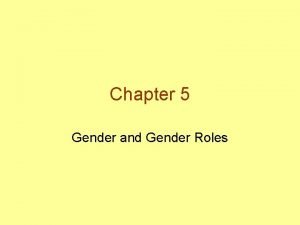The Continuing Gender Revolution in Housework Jonathan Gershuny



















- Slides: 19

The Continuing ‘Gender Revolution’ in Housework Jonathan Gershuny*, Oriel Sullivan* and John Robinson** *University of Oxford **University of Maryland May 2014 ACKNOWLEDGEMENTS: We gratefully acknowledge the support of the UK Economic and Social Research Council (grant references ES/L 011662/1; ES-060 -25 -0037, ES-000 -23 -TO 704 and ES-000 -23 -TO 704 -A) and the European Research Council (grant reference 339703) for their financial support. We also thank Professor Michael Bittman for enabling Professor Gershuny to conduct analysis on the Australian data in Sydney during January 2013.

Outline of this presentation. • We use the Multinational Time Use Study to provide evidence of historical change in individuals’ work balances. • We present sociological theory (Coleman 1990, Gershuny et al 2005, Sullivan 2006), plus household panel study and time-diary evidence, to reconsider the “stalled revolution” thesis. • We use the British Household Panel Study, the German Socio-economic Panel & the Panel Study of Income Dynamics, to provide evidence of microsocial change mechanisms.

The “Stall” thesis • Recent New York Times articles (Coontz, 2013, Cohen 2014) report that progress in gender equality slowed in the late 1990 s and early 2000 s. • “Stalling” of change identified in: • women’s employment rates, • gender segregation of school subjects, • attitudes towards gender equality, • division of unpaid labour, …and related to “gender essentialism”. (England, 2010; Cotter, Hermsen & Vanneman, 2011) • We’ll focus on paid/unpaid labour balance.

Gender essentialism • A claim of essential differences between men’s and women’s orientation to family and work. Within economists’ rational choice framework, this emerges where otherwise similar men and women make different choices. • Core sociological view: gender is constructed. Gendered behaviours emerge, in real elapsed time, and under specific historical conditions. • Hence, the explicit representation of the passage of historical time in sociological theory.

MTUS Simple File evidence • 53 surveys. . . • … from the 14 countries for which studies were available for more than one decade… • … covering the period 1961 -2010… • … and including only the 500, 000 days of diary data from respondents aged 20 to 59.

Core housework by gender 100 325 90 men's cooking, cleaning and laundry minutes per day Australia 80 275 Canada Denmark 70 Finland France 60 225 Germany Italy 50 Netherlands 175 40 Norway Slovenia 30 125 Sweden women's cooking, cleaning and laundry minutes per day 20 UK 1970 s 1980 s 1990 s USA 10 75 1960 s Spain 2000 s 0 1960 s 1970 s 1980 s 1990 s 2000 s

All unpaid work by gender 450 Women's unpaid work (housework, shopping childcare etc) minutes/day 400 180 160 Men's unpaid work (housework, shopping childcare etc) minutes/day 140 Australia Canada Denmark Finland 120 350 France Germany 100 Italy 300 Netherlands 80 Norway 250 60 Slovenia Spain 40 Sweden 200 UK 20 USA 150 1960 s 1970 s 1980 s 1990 s 2000 s

Women’s % of unpaid and all work 90 60 women's proportion of all (men’s + women’s) unpaid work 85 58 women's work time as a proportion of all (men’s + women’s) paid+unpaid work 56 Australia Canada 80 Denmark 54 Finland 52 France 75 Germany 50 70 Italy Netherlands 48 Norway Slovenia 46 65 Spain 44 Sweden 60 UK 42 USA 40 55 1960 s 1970 s 1980 s 1990 s 2000 s

MTUS Simple File: findings Findings: – Continuing gender convergence in paid & unpaid work time. – No systematic gender differences in total work time. – Considerable remaining gender differences in the paid/unpaid balance, perhaps persistent gender wage gaps (Becker 1991 p 56). What do they tell us?

How do we explain these findings? Rational choice models don’t really help (dependence on unobserved preference structures leading to indeterminate predictions, absence of historical context, inattention to rates of change, etc) We need, instead: – Theory recognising both historical time and multilevel interactions of individual agents with social structures (Sullivan 2004, 2006), involving… – …testable mechanisms which explain how individuals’ actions lead to historical change in social structures—and social-structural changes lead in turn to new patterns of action (eg Gershuny et al 1994).

Why women’s actions continue to be different from men’s.

An example of a change mechanism: lagged adaptation

An example of a change mechanism: lagged adaptation

Effects of wife’s employment on division of domestic labour Annual Change in weekly domestic work hours, USA, Germany and UK Q’nnaire “How many hours last week? ” data, national representative household panels 1980 s-2000. OLS regressions, case = married or cohabiting couple, pooled pairs of successive years. (developed from Gershuny, Bittman and Brice, JMF 2005, Tables 2 and 3) (* p <. 05 ** p <. 01) Wife’s year-to-year employment status change: She stays full time Full time part time Full time not empl. Part time full time She stays part time Part time not empl. Not empl. full time Not empl. part time She stays not employed Wife’s year-on-year change in weekly domestic work hours UK Germany USA BHPS SOEP PSID Husband’s year-on-year change in weekly domestic work hours UK Germany USA BHPS SOEP PSID N=16, 044 N=14, 161 N=7, 423 -0. 38 1. 10 0. 21 2. 33 2. 13 1. 92 -0. 19 -0. 14 -0. 06 -0. 34 -0. 51 -1. 44 5. 98** 8. 02** 7. 23** -1. 44** -1. 76** -2. 48* -2. 50** -0. 26 -2. 21 -0. 25 2. 65 0. 60 0. 31 0. 18 0. 62 0. 23 -0. 53 -. 90 2. 85** -4. 41** 2. 79** -7. 81** 2. 53 -7. 74** -0. 70* 1. 75** -1. 05* 2. 59** -2. 01 1. 71 -3. 57** (ref) -3. 79** (ref) -4. 68 (ref) 0. 24 (ref) -. 37 (ref) -0. 74 (ref) (also controlling for husbands’ annual employment change and age of youngest children)

For example: lagged adaptation • Little/no employment ratchet, none in US: – Wife full time not empl. +7. 23 hours housework for wives – Wife not employed full time -7. 74 hours for wives • BUT large gender asymmetry, eg Germany: – Wife not employed full time -7. 81 hours housework for wives – Wife not employed full time +2. 59 hours for husbands • Dual burden effects (ft >=30 hrs paid work/week) • Dual burden diminishes over subsequent years – wives’ housework declines, husbands’ increase each year up to 5 years after entry to paid work (Gershuny et al 2005 Table 4). • But adaptation partial, incomplete convergence – US wives’ 2*husbands’ housework, UK 3*, Germany 5*, after 5 years

Summary and conclusions 1 Sociological models (unlike economists’ rational choice approaches) are essentially historical: 1. Changes in normative structures are necessarily slow; individual practices are to some degree grounded on beliefs about previous states of society, partial knowledge of present circumstances, incomplete understanding of consequences. 2. Hence outcomes of behaviour are often perceived as unfair or unwanted, and lead to pressure for future compensating change in norms and regulations 3. In turn, as individual concerns slowly coalesce to shape public discourse, the institutions contributing to societal change (media, interest groups, political parties, public agencies etc. ) gradually adjust norms and regulations.

Summary and conclusions 2 The progress of change is not inevitable: specific institutional-level changes are required, to enable and motivate future change for individuals. For example: 1. The consequence of the remaining 60/40 gender difference in the paid/unpaid work balance is inequality between men’s and women’s ‘human capital’ (ie earnings capabilities). Hence… 2. … further institutional changes are needed to ‘level the playing field’ for choices of labour market and family formation strategies: • More provision of pre-school childcare facilities. • Tax allowances or public subsidies for these. • Strongly supported gender-neutral parental leave.

Summary and conclusions 3 In short: historical processes of social change should be expected to be slow, and to include periods of levelling-off (even reversal). So we should wait to make judgements about stalling, and ‘essential’ gender differences!

• • • References Becker, Gary S, A Treatise on the Family, Harvard University Press, enlarged edition 1991. Burda, Michael, Daniel S Hamermesh and Philippe Weil. (2013). “Total Work and Gender: Facts and Possible Explanations” Journal of Population Economics 26(1), 239 -261. Cohen, Philip, N. “How can we Jump-start the Struggle for Gender Equality? ” New York Times Opinion Pages: 23 rd November Coleman, James S (1990) Foundations of Social Theory Cambridge, Massachesetts : The Bellknap Press of Harvard University Press Coontz, Stephanie (2013) “Why Gender Equality Stalled”. New York Times Sunday Review: 16 th February David Cotter, Joan M. Hermsen, and Reeve Vanneman (2011), “The End of the Gender Revolution? Gender Role Attitudes from 1977 to 2008”. American Journal of Sociology, Vol. 117, No. 1 pp. 259 -289 England, Paula (2010). “The Gender Revolution : Uneven and Stalled”. Gender & Society pp. 24149 Gershuny, Jonathan, Michael Godwin and Sally Jones (1994) "The Domestic Labour Revolution: a Process of Lagged Adaptation" in M. Anderson, F. Bechhofer and J. Gershuny (eds) The Social and Political Economy of the Household. Oxford: Oxford University Press/ Gershuny, Jonathan Michael Bittman and John Brice (2005) “Exit, Voice and Suffering: Do Couples Adapt to Changing Employment Patterns? ” Journal of Marriage and Family Vol 67 (August): pp 656 -665. Sullivan, Oriel (2004) ‘Changing gender relations within the household: a theoretical perspective’. Gender & Society 18/2, 207 -223 Sullivan, Oriel (2006) Changing Gender Relations, Changing Families: Tracing the Pace of Change. New York: Rowman and Littlefield (Gender Lens Series), pp. 141
 Noun as direct object
Noun as direct object Strategic gender needs and practical gender needs
Strategic gender needs and practical gender needs The third agricultural revolution
The third agricultural revolution Russian revolution vs french revolution
Russian revolution vs french revolution How could the french revolution been avoided
How could the french revolution been avoided Iec dallas continuing education
Iec dallas continuing education Which verb tenses describe continuing action?
Which verb tenses describe continuing action? Fclb
Fclb Assertive continuing care
Assertive continuing care Imslec certification
Imslec certification Sra continuing competence
Sra continuing competence What habits and characteristics do test-wise students have?
What habits and characteristics do test-wise students have? Continuing professional development
Continuing professional development Georgetown school of continuing studies reputation
Georgetown school of continuing studies reputation Tesol course university of queensland
Tesol course university of queensland Ronic formula
Ronic formula San diego continuing education north city campus
San diego continuing education north city campus Aea continuing education
Aea continuing education Continuing competence
Continuing competence Bladen community college online classes
Bladen community college online classes





































